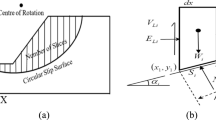Abstract
This study investigates the technique of variational calculus applied to estimate the slope stability considering the mechanism of planar failure. The critical plane failure surface should be determined because it theoretically indicates the most unfavorable plane to be considered when stabilizing a slope to rectify the instability generated by several statistically possible planes. This generates integrals that can be solved by numerical methods, such as the Newton Cotes and the finite differences methods. Additionally, a system of nonlinear equations is obtained and solved. The surface of the critical planar failure is determined by applying the condition of transversality in mobile boundaries, for which various examples are provided. The number of slices is varied in one of the examples, while the surface of the critical planar failure is determined in the others. Results are compared using analytical methods through axis rotations. All the results obtained by considering normal stress, safety factors, and critical planar failure are nearly the same; however, in this research, a study is carried out for “n” number of slices using programming methods. Sub-routines are important because they can be applied in slopes with different geometry, surcharge, interstitial pressure, and pseudo-static load.
Similar content being viewed by others
References
Coggan J S, Stead D, Eyre J M. Evaluation of techniques for quarry slope stability assessment. Transactions of the Institution of Mining and Metallurgy. Section B. Applied Earth Science, 1998, 107: 139–147
Shnorhokian S, MacNeil B, Mitri H. Volumetric analysis of rock mass instability around haulage drifts in underground mines. Journal of Rock Mechanics and Geotechnical Engineering, 2018, 10(1): 60–71
Wyllie D C, Mah C. Rock Slope Engineering. 4th ed. New York: CRC Press, 2004
Chen W F, Giger M W, Fang H Y. On the limit analysis of stability of slopes. Soil and Foundation, 1969, 9(4): 23–32
Chen W F. Limit Analysis and Soil Plasticity. Amsterdam: Elsevier, 1975
Chen J, Yang Z, Hu R, Zhang H. Study on the seismic active earth pressure by variational limit equilibrium method. Shock and Vibration, 2016, 2016: 1–10
Terzaghi K. Mechanism of landslides. Application of geology to engineering. Geological Society of America, 1950, 83–123
Baker R, Shukha R, Operstein V, Frydman S. Stability charts for pseudo-static slope stability analysis. Soil Dynamics and Earthquake Engineering, 2006, 26(9): 813–823
Nouri H, Fakher A, Jones C. Evaluating the effects of the magnitude and amplification of pseudo-static acceleration on reinforced soil slopes and walls using the limit equilibrium horizontal slices method. Geotextiles and Geomembranes, 2008, 26(3): 263–278
Zhang Y B, Chen G Q, Zen K, Kasama K, Dong S. Limit analysis of seismic slope stability based on tension-shear failure mechanism. In: The 89th International Symposium on Rock Slope Stability in Open Pit Mining and Civil Engineering. Vancouver, 2016, 77–90
Liu G, Zhuang X, Cui Z. Three-dimensional slope stability analysis using independent cover based numerical manifold and vector method. Engineering Geology, 2017, 225: 83–95
Rabczuk T, Zi G, Bordas S, Nguyen-Xuan H. A simple and robust three-dimensional cracking-particle method without enrichment. Computer Methods in Applied Mechanics and Engineering, 2010, 199(37–40): 2437–2455
Ren H, Zhuang X, Cai Y, Rabczuk T. Dual-horizon peridynamics. International Journal for Numerical Methods in Engineering, 2016, 108(12): 1451–1476
Ren H, Zhuang X, Rabczuk T. Dual-horizon peridynamics: A stable solution to varying horizons. Computer Methods in Applied Mechanics and Engineering, 2017, 318: 762–782
Zhou S, Zhuang X, Zhu H, Rabczuk T. Phase field modelling of crack propagation, branching and coalescence in rocks. Theoretical and Applied Fracture Mechanics, 2018, 96: 174–192
Zhou S, Zhuang X, Rabczuk T. Phase field modeling of brittle compressive-shear fractures in rock-like materials: A new driving force and a hybrid formulation. Computer Methods in Applied Mechanics and Engineering, 2019, 355: 729–752
Zhou S, Zhuang X, Rabczuk T. Phase-field modeling of fluid-driven dynamic cracking in porous media. Computer Methods in Applied Mechanics and Engineering, 2019, 350: 169–198
Kopácsy J. Distribution of stresses at failure shape of the sliding surface and theoretical slope height. In: Proceedings of the fifth International Conference on Soil Mechanics and Foundation Engineering. Paris: Dunod, 1961, 641–650
Baker R, Garber M. Discussion of ‘On slip surface and slope stability analysis.’ by Chen W F, Snitbhan N. Soils and Foundations, 1977, 17(1): 65–68
Baker R, Garber M. Theoretical analysis of the stability of slopes. Geotechnique, 1978, 28(4): 395–411
Castillo E, Revilla J. An application of the calculus of variations to the slope stability. Soil Mechanics Transport Laboratory Newsletter José Luis Escario, 1976, 115: 3–23 (in Spanish)
Luceño A, Castillo E. Critical analysis of variational methods applied to slope stability. Soil Mechanics Transport Laboratory Newsletter José Luis Escario, 1980, 45: 3–14 (in Spanish)
Rojas S, Úcar R. Critical analysis of variational methods applied to slope stability. Science and Engineering, 2001, 22(1): 30–40
Leshchinsky H, Huang C C. Generalized slope stability analysis: Interpretation, modification and comparation. Journal of Geotechnical Engineering, 1992, 118(10): 1559–1576
Mac-Lennan J. Failure of a slope. Journal of Public Works: Organism Professional Engineers of Roads, Canals and Ports, 2004, 3446: 53–60
Úcar R. Anchor manual in Civil Engineering. Madrid: Arias Montano Graphics’s, 2004 (in Spanish)
Baker R. Variational slope stability analysis of materials with nonlinear failure criterion. Electronic Journal of Geotechnical Engineering, 2005, 10: 1–22
Belandría N, Úcar R, Bongiorno F. Determination of mathematical expressions for calculating the stresses applied to slope stability. Sciencie and Engineering, 2011, 32(3): 115–122 (in Spanish)
Puig Adam P. Theoretical-practical Course of Differential Equations Applied to Physics and Technique. Madrid: Roberto Puig Alvarez, 1975 (in Spanish)
Elsgoltz L. Differential Equations and Variational Calculus. Moscu: MIR, 1969 (in Spanish)
Author information
Authors and Affiliations
Corresponding author
Rights and permissions
About this article
Cite this article
Belandria, N., Úcar, R., León, F.M. et al. Stability analysis of slopes with planar failure using variational calculus and numerical methods. Front. Struct. Civ. Eng. 14, 1262–1273 (2020). https://doi.org/10.1007/s11709-020-0657-9
Received:
Accepted:
Published:
Issue Date:
DOI: https://doi.org/10.1007/s11709-020-0657-9




